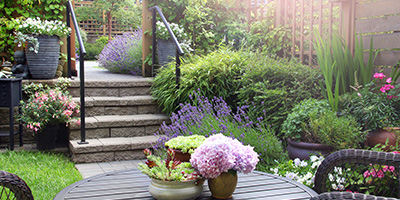9 Horse Barn Maintenance Tips for First-Time Horse Owners

Horse Barn Maintenance
If you’ve decided to take on the Chip and Joanna Gaines rural farm lifestyle – horses and all – it’s important to keep in mind a few horse barn maintenance tips as a beginner. “A healthy horse means a happy owner,” says Kim Houlding of the Iowa Horse Council.
A well-maintained horse barn can “prevent physical accidents, prevent fires, provide disease and parasite control, and help you save on veterinary bills,” says Houlding. To keep your new animals thriving for years to come, add these nine maintenance tips to your barn chores checklist.
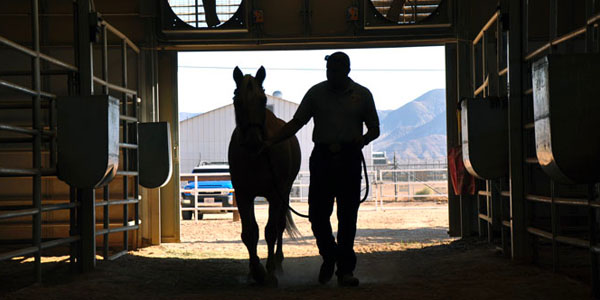
9 Barn Maintenance Tips to Keep Your Horses Happy and Healthy
1. Keep the Barn Well-Ventilated
To protect your animals’ health, make sure your horse barn chore checklist includes regular airflow checks and ventilation maintenance. The key is to move moist, dust-laden air out of the barn to prevent mold and respiratory problems for your horses.
How to Keep a Barn Well-Ventilated
- Install ceiling fans, but leave at least 12 feet of clearance in case your horse rears up.
- Use exhaust fans in the roof and eaves to vent hotter air out from the barn.
- Provide open space above stalls to prevent heat and stale air from becoming trapped.
- Give each stall its own vent to improve airflow.
- Leave barn doors open during the day, even in the winter – horses can handle the cold.
- Invest in a large livestock floor fan to keep air moving across the center of the barn.
Cleaning horse stalls properly is another important tip for sustaining good air quality for your animals, as it prevents ammonia buildup.
2. Pest Proof Your Barn
The warm hay and plentiful grain of horse barns is practically an open invitation to rodents and other animals. Having rats in the barn can bring fleas, disease and structural damage to your livestock’s living space. Cleaning your horses’ stalls, having good stable organization and using rodent-proof containers for their feed are important for keeping rats and mice at bay.
But if the critters have already made your horses’ home their own, here are a few tips for getting them out for good:
How to Get Rid of Rats in the Barn
- Cut off their food supply – sweep stalls daily and dispose of grain in sealed trash bins.
- Use metal rodent-proof horse feed storage bins – plastic is no match for a hungry rat.
- Tightly contain feed bins and keep them off the floor, either on shelves or pallets.
- Lay snap traps along walls for smaller rats and mice.
- Set cage traps for bigger rats, raccoons and opossums.
- Leave sweet, aromatic bait like marshmallows or peanut butter to draw them out.
- Get a pair of barn cats for regular pest control.
- Avoid toxic bait, especially if you have barn cats who may try to eat the poisoned rats.
3. Store Saddles Correctly to Protect Your Horse’s Back
Saddles are big investments, making their care an important part of horse barn maintenance. They need to be stored properly to keep your four-legged friends safe during rides, says Terri Beecher of Out West Saddlery:

"You can torture your horse’s back with a bad or damaged saddle. That’s why when storing a saddle, you don’t want to keep it anywhere hot like a trailer, especially if using a saddle tree stand. The heat can warp the shape, which can harm the horse’s back when you try to ride with it."
Terri Beecher, Out West Saddlery
Tips for Proper Saddle Storage in the Barn
- Remove dust and dirt from your saddle before putting it away.
- If it needs a deep clean, don’t put it away wet – air-dry it in a shady spot outside first.
- Use a saddle stand to maintain your saddle’s shape and keep it away from heat.
- Never store a saddle on its side or on its fork – this can warp the leather.
- Cover saddles with a breathable saddle cover to keep dust (and mice) off.
- Use a dehumidifier in your tack storage area to keep humidity from hurting the leather.
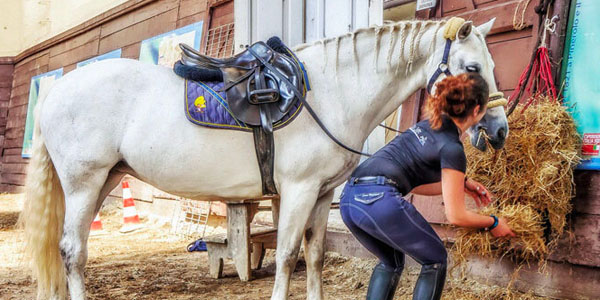
4. Improve Your Hay and Horse Feed Storage
Stable organization is crucial for good barn maintenance, as horse feed and hay can go bad if stored improperly. Not to mention that some horses may take an unsecured feed bin as an open buffet invitation. To protect your horses’ food supplies from the elements and themselves, here are some tips for proper feed storage in your horse barn:
Horse Feed Storage Ideas
- Dedicate a locked, closed-off area to horse feed storage to keep it out of nose’s reach.
- Store feed and hay off the ground on pallets to prevent mold from developing.
- Use bungee cords to strap feed container lids down tightly.
- Keep grain bins out from underneath leaky rooves and other high-moisture areas.
- If stacking hay, keep the bales at a safe, manageable height to prevent a hay avalanche.
- Keep feed and hay away from any water sources in the barn, if possible.
While horses shouldn’t have unlimited access to grains, they do need regular access to hay and grass to stay healthy, as Beecher explains:

"Horses release stomach acid 24/7, whereas humans only do so while we’re eating. They normally graze close to 20 out of 24 hours of the day, and need to do so to prevent ulcers and anxiety. I’m a huge advocate of free feeding from slow feed hay nets. You can hang them high up in trees or around the barn. This will allow access while preventing hay from getting dirty on the ground."
Terri Beecher, Out West Saddlery
5. Keep Barn Stalls Clean and Dry
Cleaning horse stalls and keeping them moisture-free is important for good horse barn maintenance. Stall cleanings are a must for daily barn chore checklists, as a wet or dirty horse stall can present a slipping hazard and introduce disease and bacteria into your barn.
In addition to keeping your animals healthy, regular cleanings and maintenance can protect wooden horse stalls from wood rot, insects and mold growth in the long run.
Horse Stall Cleaning Tools
- Heavy duty corn broom
- Pitchfork
- Muck bucket cart
- Rake
- Scoop shovel
- Stall freshener
How to Clean a Horse Stall
- Use the pitchfork to sift manure from the shavings, removing wet shavings with it.
- Place the manure and wet shavings into your muck bucket cart.
- Once you’ve finished mucking, use pine shavings to sop up any remaining wet spots.
- Use a stall freshener like Sweet PDZ to neutralize any ammonia smells.
- Sweep sawdust away from the feeding area and rake up any remaining particles.
Barn Chore Checklists
Horse stalls should be mucked out at least once a day and no less than six times a week. We asked the Iowa Horse Council for a list of other recurring tasks on barn chore checklists:
Daily Barn Maintenance Tasks | Weekly Barn Maintenance Tasks | Annual or Semi-Annual Barn Maintenance Tasks |
|---|---|---|
• Clean stalls | • Clean water buckets | • Check fire alarms |
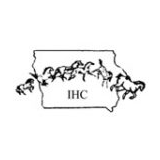
Kim Houlding, Iowa Horse Council
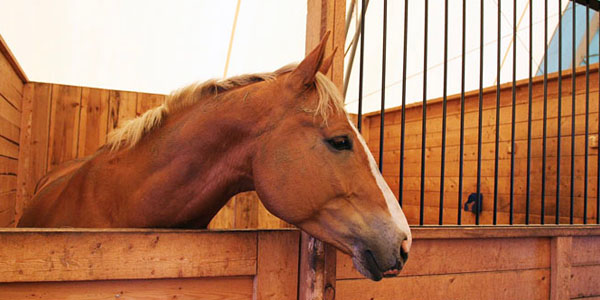
6. Check for Safety Hazards During Horse Stall Maintenance
“Horses could hurt themselves even in a padded room,” says Beecher. That’s why keeping stalls free from potential hazards should be at the top of your barn chores checklist at all times. In order to keep them contained safely, here are a few safety hazards to check for when cleaning your horse stalls.
Horse Stall Safety Hazards Checklist
- Tighten screws or nails that may have popped out of wood surfaces.
- Be sure that latches are securely attached to doors and gates.
- Inspect wood for splinters or splits that could poke or catch your horse.
- Provide anti-cast strips to prevent your horse from becoming stranded on its back.
- Check the floor for nails or protrusions that could harm the insides of their hooves.
- Make sure the floor is level and slip-proof, especially if your horses wear shoes.
- Remove ropes or other items that a horse could become tangled in or trip on.
- Use solid walls to separate horses; nothing a kicking hoof could become trapped in.
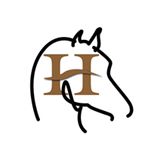
"[For additional safety,] I also like to have tongue and groove walls in stalls or an anti-cast strip installed so that a horse that lays down too close to the wall can get its feet underneath of something to push off and get himself up. Also, electric sockets need to have covers if they are near a stall door or gate and should never be too close to water outlets."
Karen Tappenden, Holistic Horse
7. Opt for a Safe, Low-Maintenance Barn Floor Option
Speaking of barn maintenance tips for safety, your barn floor should also be a top priority. Old, poorly maintained floors can be unsafe for your animals to walk on. If your barn floors are worn or eroded beyond repair, you may want to replace it with an easy-to-maintain barn floor option.

"I would look at a grid system for the floor that is filled with gravel so the floor drains and the gravel is not dug out with the mucking. I had it in a 3-stall barn and worked in a 30-stall barn. I never had any slipping issues and the stalls were much easier to maintain."
Karen Tappenden, Holistic Horse
More Low-Maintenance Barn Floor Options
- Concrete: This is the easiest barn floor option to clean, but you may need to invest in rubber livestock mats to make it softer for your horses’ hooves.
- Gravel: When used over a grid barn floor, gravel allows water to drain away easily.
- Asphalt: Asphalt is a popular barn floor option, as it is easy to clean and durable.
- Clay: This material is affordable, easy on hooves and reduces slippage in your stables.
- Dirt: Inexpensive, and as natural as it gets, dirt is a great barn floor option when topped with sawdust and drained well.
For concrete and asphalt floors, it’s important to use plenty of bedding and rubber mats to protect your horses from hock, elbow and fetlock sores.
8. Invest in Barn Roof Repair and Maintenance
Barn roofs keep your hooved friends (and everything that comes with them) safe from the elements, so it’s important to perform routine maintenance checks to ensure they’re in working condition.
Barn Roof Repair and Maintenance Checklist
- Inspect for leaks during big rainstorms – check for water on walls or pools around the barn, as the water will rarely drip straight down.
- Clear tree debris away after storms to prevent mold and insects from making a home.
- Prune nearby trees and remove nearby dead or damaged trees to prevent fall-ins.
- If you notice a shingle flapping in the breeze, fix it right away to prevent further issues.
- Check the fasteners to prevent pieces of roof from flying away in inclement weather.
- For large-scale moisture or UV damage, contact a barn roof repair specialist for help.
Repairing Your Barn Roof or Floor?
Rent a Roll Off Dumpster to Easily Toss Project Debris!
9. Keep Bugs Out (Safely)
From flies to termites, bug control is a must-have on horse owners’ barn chore checklists, but it’s important to use horse-friendly repellents to do it. “Most fly sprays are chemical poisons, which horses can absorb into their skin,” says Beecher. “I like to switch back and forth between Natural Fly Spray and Flicks, both economical, natural fly sprays to use in the barn.”
Dry wood termites can spell disaster for wooden barns, so it’s also crucial to include annual termite checks in your horse barn maintenance routine. Your local pest control company can help you find animal-friendly pre-treatments for horse stalls to safely keep wood-hungry nuisances at bay.
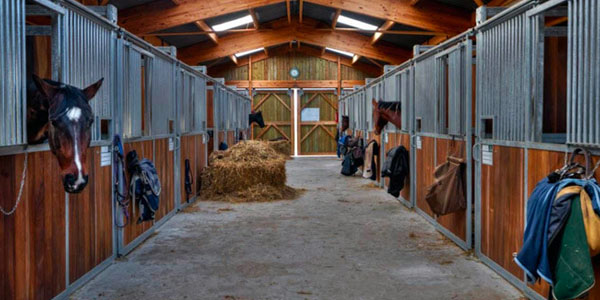
The Best Barn Maintenance Tip? Keep an Eye on Your Horses
Horse barn maintenance routines may differ slightly from owner to owner, but the easiest way to tell if your hard work is paying off is to pay attention – to your horses, that is. “It’s good to look at your animals and make sure they’re not sick or injured on a regular basis,” says Beecher. “People think that horses are like motorcycles but they’re not. They’re living, breathing, sensitive and amazing animals that are also a big commitment.”
If you start noticing changes in your horse’s appearance or behavior, take a closer look at their surroundings. Is their bedding deep enough? Do they have enough space in their stall? Is their food fresh and dry? Understanding your animals and their individual needs is the key to keeping a happy and healthy horse barn.

